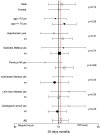Primary PCI during off-hours is not related to increased mortality
- PMID: 24062885
- PMCID: PMC3760552
- DOI: 10.1177/2048872612441581
Primary PCI during off-hours is not related to increased mortality
Abstract
Aim: Previous studies have shown contradictory outcomes in ST-segment elevation myocardial infarction (STEMI) patients who underwent primary percutaneous coronary intervention (pPCI) during off-hours versus regular 'office' hours. We aimed to evaluate the relationship between pPCI timing (off-hours versus regular hours) and mortality in patients with STEMI undergoing pPCI.
Methods: The study population comprised 4352 consecutive STEMI patients treated with pPCI in a high-volume centre with a 24/7 programme during 2000-2009. Descriptive statistics and multivariable survival analyses were applied to evaluate the relationship between treatment during off-hours (Monday-Friday, 6.00 pm-8.00 am and weekends) versus regular hours and the incidence of all-cause mortality at 30-day and 4-year follow-up.
Results: A total of 2760 patients (63.4%) were treated during off-hours and 1592 patients (36.6%) during regular hours. With the exception of smoking, diabetes mellitus, use of glycoprotein IIb/IIIa antagonists and calcium antagonists, no major differences in baseline characteristics were observed between the groups. Mortality at 30-day follow-up was similar in patients treated during off-hours and those treated during regular hours (7.7% vs 7.7%; hazard ratio adjusted for potential confounders 1.03; 95% CI 0.82-1.28). Four-year mortality was similar (17.3% vs 17.3%; adjusted hazard ratio 0.95; 95% CI 0.81-1.11).
Conclusion: In STEMI patients who present during off-hours in a high-volume centre with 24/7 service, pPCI provides similar survival as patients who were treated during regular hours.
Keywords: STEMI; off hours; outcome; primary percutaneous coronary intervention.
Conflict of interest statement
None declared by authors.
Figures
References
-
- Keeley EC, Boura JA, Grines CL. Primary angioplasty versus intravenous thrombolytic therapy for acute myocardial infarction: a quantitative review of 23 randomised trials. Lancet 2003; 361:13–20 - PubMed
-
- Smith SC, Jr, Feldman TE, Hirshfeld JW, Jr, et al. , American College of Cardiology/American Heart Association Task Force on Practice G, Intervention AASWCtUtGfPC ACC/AHA/SCAI 2005 guideline update for percutaneous coronary intervention: a report of the American College of Cardiology/American Heart Association Task Force on Practice Guidelines (ACC/AHA/SCAI Writing Committee to Update the 2001 Guidelines for Percutaneous Coronary Intervention). J Am Coll Cardiol 2006; 47: e1–121 - PubMed
-
- Van de Werf F, Bax J, Betriu A, et al. , Guidelines ESCCfP. Management of acute myocardial infarction in patients presenting with persistent ST-segment elevation: the Task Force on the Management of ST-Segment Elevation Acute Myocardial Infarction of the European Society of Cardiology. Eur Heart J 2008; 29: 2909–45 - PubMed
-
- Cannon CP, Gibson CM, Lambrew CT, et al. Relationship of symptom-onset-to-balloon time and door-to-balloon time with mortality in patients undergoing angioplasty for acute myocardial infarction. JAMA 2000; 283: 2941–47 - PubMed
-
- De Luca G, Suryapranata H, Ottervanger JP, et al. Time delay to treatment and mortality in primary angioplasty for acute myocardial infarction: every minute of delay counts. Circulation 2004; 109: 1223–25 - PubMed
LinkOut - more resources
Full Text Sources
Miscellaneous



